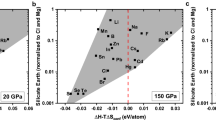Abstract
IT has long been realized that earthquakes are often associated with various kinds of anomalous electromagnetic phenomena. These phenomena might be caused by rock failure in the Earth's crust, but the details of the mechanisms are still unknown. Here we describe an attempt to measure the emission of charged particles from rocks undergoing indentation fracture under atmospheric conditions, using a specially designed indentation system. High electron and ion emission intensities could be detected during parts of the loading cycle when cracking occurred around the indent. The emission behaviour of feldspar and quartz in granite was different from that of the hygroscopic matrix of hornblende andesite; moisture in the hornblende andesite enhanced emission appreciably. The different behaviour observed may be attributable to two different mechanisms.
This is a preview of subscription content, access via your institution
Access options
Subscribe to this journal
Receive 51 print issues and online access
$199.00 per year
only $3.90 per issue
Buy this article
- Purchase on Springer Link
- Instant access to full article PDF
Prices may be subject to local taxes which are calculated during checkout
Similar content being viewed by others
References
Ogawa, T., Oike, K. & Miura, T. J. geophys. Res. 90, 6245–6249 (1985).
Brady, B. T. & Rowell, G. A. Nature 321, 488–492 (1986).
Khatiashvili, N. G. & Perel'man, M. E. Phys. Earth planet. Interiors 57, 169–177 (1989).
Woilbrandt, J., Linke, E. & Meyer, K. Phys. Stat. Sol. 27, K53–K55 (1975).
Dickinson, J. T., Donaldson, E. E. & Park, M. K. J. Mater. Sci. 16, 2897–2908 (1981).
Kornfeld, M. I. J. Phys. D11, 1295–1301 (1978).
Dickinson, J. T., Jensen, L. C. & Williams, W. D. J. Am. Ceram. Soc. 68, 235–240 (1985).
Enomoto, Y. & Hashimoto, H. J. Mater. Sci. Lett. 8, 1107–1109 (1989).
Heinicke, G., Tribochemistry (Carl Hanser Munchen, Wien, 1984).
Vladikina, T. N., Derjaguin, B. V., Kluev, V. A., Toporov, Yu. P. & Khrustalev, Yu. A. J. Lubrication Engng 102, 552–555 (1980).
Gesell, T. F., Arakawa, E. T. & Callcott, T. A. Surface Sci. 20, 174–178 (1970).
Nakamura, K. & Tsunenishi, Y. Bull. Earthquake Res. Inst. 44, 1371–1384 (1966).
Derr, J. Bull. seism. Soc. Am. 63, 2177–2187 (1973).
Rikitake, T. et al. Bull. Earthquake Res. Inst. 44, 363–408 (1966).
Author information
Authors and Affiliations
Rights and permissions
About this article
Cite this article
Enomoto, Y., Hashimoto, H. Emission of charged particles from indentation fracture of rocks. Nature 346, 641–643 (1990). https://doi.org/10.1038/346641a0
Received:
Accepted:
Issue Date:
DOI: https://doi.org/10.1038/346641a0
Comments
By submitting a comment you agree to abide by our Terms and Community Guidelines. If you find something abusive or that does not comply with our terms or guidelines please flag it as inappropriate.



